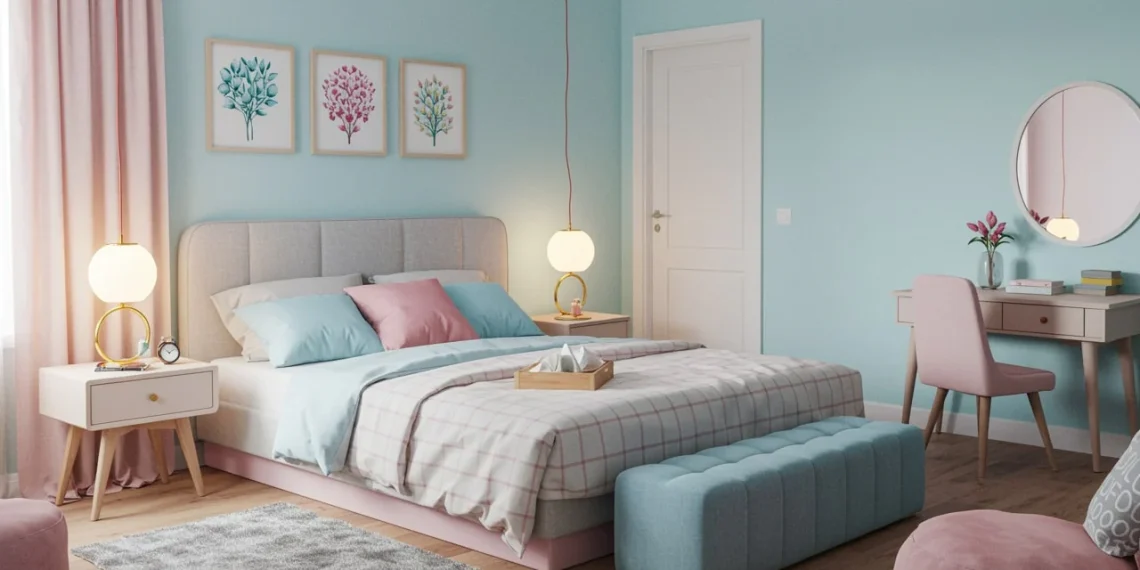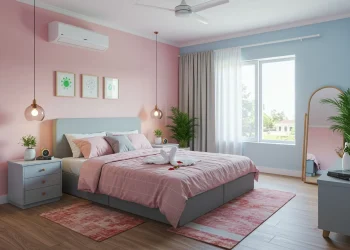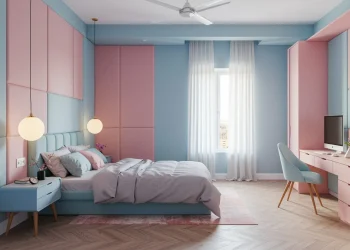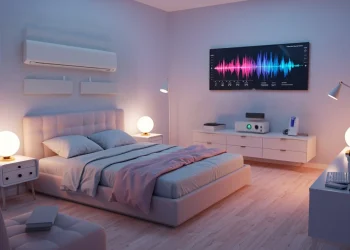In Indian households, the bedroom represents far more than a simple sleeping space—it’s a sanctuary where families find peace, couples reconnect, and individuals recharge for tomorrow’s challenges. Your bedroom setup serves as the foundation for quality rest, affecting not just your sleep patterns but your overall well-being and family harmony.
Research consistently shows that our sleep environment directly impacts sleep quality, with factors like lighting, temperature, and spatial arrangement influencing how quickly we fall asleep and how deeply we rest. For Indian families, creating an optimal bedroom layout involves balancing traditional values with modern comfort needs, especially in urban spaces where every square foot matters.
Whether you’re designing a master bedroom in a spacious home or optimizing a compact apartment room, the principles of sleep-optimized design can transform your space into a haven that promotes restorative sleep. The key lies in understanding how cultural preferences, family dynamics, and individual needs intersect with proven sleep science principles.
Cultural Foundation for Indian Bedrooms
Traditional Wisdom Meets Modern Comfort
Indian bedroom design has evolved through millennia, blending ancient architectural principles with contemporary lifestyle demands. Traditional Indian homes emphasized the bedroom as a private retreat, incorporating elements that promoted both physical comfort and spiritual well-being.
Vastu Shastra, India’s ancient science of architecture, offers time-tested guidelines for bedroom placement and layout. According to these principles, the master bedroom should ideally occupy the southwest corner of the house, promoting stability and restful sleep. The bed itself should be positioned so that sleepers’ heads face south or east, aligning with natural magnetic fields for deeper rest.
Modern Indian families are rediscovering these traditional concepts, finding that ancient wisdom often aligns with contemporary sleep research. For instance, the Vastu principle of keeping the bedroom clutter-free mirrors modern studies showing that visual chaos disrupts sleep quality and increases stress hormones.
Family Hierarchy and Bedroom Design
In traditional Indian households, bedroom allocation reflects family structure and relationships. Elder family members typically occupy rooms with eastern exposure, believed to enhance health and longevity. Younger couples often prefer bedrooms with southern or western orientations, which provide different energy patterns according to Vastu principles.
This hierarchical approach to bedroom design extends to furniture selection and placement. Family elders might choose heavier, more ornate furniture pieces that convey stability and wisdom, while younger family members gravitate toward minimalist designs that support their dynamic lifestyles.
Understanding these cultural nuances helps create bedroom layouts that honor family traditions while incorporating modern comfort elements. The challenge lies in balancing individual preferences with collective family harmony.
Multi-Generational Household Considerations
Indian joint families face unique bedroom design challenges, particularly in urban apartments where space is limited. Creating sleep environments that accommodate different age groups, sleep schedules, and privacy needs requires thoughtful planning and creative solutions.
Sound insulation becomes crucial in multi-generational homes, where elderly family members might retire early while younger members maintain different schedules. Strategic placement of bedrooms, along with sound-absorbing materials and thoughtful corridor design, helps maintain everyone’s sleep quality.
Storage solutions must also reflect multi-generational needs, with space for traditional clothing, religious items, and modern belongings. Custom wardrobes that accommodate both sarees and western wear, along with dedicated spaces for prayer books and modern gadgets, exemplify this balanced approach.
Regional Design Preferences and Sleep Benefits
Different regions of India have developed distinct bedroom design traditions that reflect local climate, culture, and available materials. Kerala homes traditionally feature high ceilings and natural ventilation systems that promote cooling, while Rajasthani designs incorporate thick walls and strategic window placement to manage desert temperatures.
These regional variations offer valuable insights for modern bedroom design. Kerala’s emphasis on natural airflow translates beautifully to contemporary bedrooms through ceiling fans, strategically placed windows, and breathable fabric choices. Rajasthani principles of thermal mass and sun protection inspire modern curtain selection and wall color choices.
Coastal regions like Goa and Mumbai have developed bedroom designs that manage humidity and salt air exposure. These principles apply to modern urban bedrooms through dehumidifier placement, material selection, and ventilation strategies.
The Psychology of Sleep Spaces
How Visual Environment Affects Sleep Quality
The visual elements in your bedroom directly impact your brain’s ability to transition into sleep mode. Research shows that cluttered, visually chaotic environments increase cortisol levels, making it harder to relax and fall asleep naturally.
Indian bedrooms often serve multiple functions—sleeping, storage, prayer, and sometimes study areas. This multifunctionality can create visual overwhelm unless carefully managed through thoughtful design and organization strategies.
Creating visual calm requires strategic use of color, texture, and spatial arrangement. Neutral color palettes with subtle Indian accents help maintain cultural identity while promoting relaxation. Warm earth tones inspired by traditional Indian textiles create a soothing atmosphere without overwhelming the senses.
Color Psychology in Indian Bedroom Design
Colors profoundly influence our psychological state and sleep quality. Traditional Indian color philosophy recognizes this connection, with specific colors recommended for different life stages and family roles.
Warm, muted colors like soft terracotta, gentle gold, and pale rose create welcoming environments that honor Indian aesthetic traditions while promoting rest. These colors reflect the warmth of Indian hospitality while maintaining the subtlety needed for quality sleep.
Cool colors like sage green and soft blue work particularly well in Indian bedrooms located in warmer climates. These shades create psychological cooling effects while maintaining the peaceful atmosphere essential for good sleep.
Avoiding overly bright or stimulating colors in the bedroom becomes especially important in Indian homes where bedrooms might double as family gathering spaces. Strategic color placement allows for cultural expression without disrupting sleep patterns.
Creating Personal Sanctuary Spaces
Every individual needs a personal retreat space, even within shared Indian households. Creating these sanctuary areas within bedroom layouts requires understanding both individual preferences and family dynamics.
Personal sanctuary spaces might include a quiet corner for meditation, a comfortable reading chair near a window, or a small area for personal collections and memories. These spaces provide psychological refuge while maintaining connection to family life.
The key lies in defining these personal areas without creating visual barriers that fragment the room. Subtle spatial definition through furniture placement, lighting, or textile choices creates intimacy while preserving the room’s overall harmony.
Stress Reduction Through Thoughtful Design
Bedroom environments can either amplify or reduce daily stress levels. Thoughtful design elements help create spaces that actively promote relaxation and mental restoration.
Natural elements like plants, natural fibers, and organic shapes help connect Indian bedrooms to the country’s rich natural heritage while providing proven stress-reduction benefits. Small indoor plants not only improve air quality but also create positive psychological associations with nature.
Incorporating traditional Indian craftsmanship through handwoven textiles, carved wood elements, or traditional artwork creates emotional connections while supporting local artisans. These meaningful elements contribute to the room’s ability to provide emotional restoration and stress relief.
Furniture Placement Mastery
Bed Positioning: The Foundation of Bedroom Layout
The bed’s position determines the entire bedroom’s energy flow and functionality. Beyond Vastu considerations, modern sleep science supports many traditional placement principles while adding contemporary insights about optimal sleep positioning.
Your bed should be positioned to provide clear views of the room’s entrance while avoiding direct alignment with the doorway. This placement creates psychological security while preventing disruruptive energy flow that can disturb sleep. The bed should also avoid placement directly under ceiling fans or air conditioning units, which can create temperature fluctuations and air disturbances.
Wall placement offers the most stability and security, with the headboard firmly against a solid wall. This positioning provides psychological grounding while offering practical benefits like reduced noise transmission and temperature stability.
Consider your partner’s preferences when determining bed placement. Different sleep styles, temperature preferences, and movement patterns influence optimal positioning. Some couples benefit from beds positioned to allow independent entry and exit, while others prefer more integrated arrangements.
Vastu-Compliant Placement Strategies
Vastu principles offer sophisticated guidance for bed placement that often aligns with modern sleep research. The recommended south-facing head position corresponds with natural magnetic field alignment, potentially supporting deeper sleep phases.
East-facing head positions are recommended for students and young professionals, as this orientation is believed to enhance learning and career growth. While scientific evidence for these specific benefits remains limited, the east-facing position does align with natural light patterns that support healthy circadian rhythms.
Avoiding north-facing head positions follows both traditional wisdom and some modern magnetic field theories. Whether or not magnetic alignment affects sleep quality, this positioning often provides practical benefits in terms of room layout and natural light exposure.
The bed should be positioned away from mirrors that reflect the sleeping area, following both Vastu guidelines and modern advice about reducing visual stimulation in sleep spaces. Mirrors can create psychological restlessness and reflect light in ways that disrupt sleep cycles.
Space Optimization in Small Indian Apartments
Urban Indian apartments require creative bed placement strategies that maximize limited space while maintaining sleep quality. Platform beds with built-in storage help optimize vertical space while providing essential storage for seasonal clothing and bedding.
Corner placement can work effectively in small bedrooms, provided the bed maintains access from both sides. This arrangement often allows for better utilization of remaining floor space for wardrobes and study areas.
Murphy beds or daybed arrangements serve dual purposes in extremely compact spaces, though these solutions require careful consideration of daily setup and breakdown routines. The key is ensuring that the sleep surface itself never compromises on quality, regardless of space-saving mechanisms.
Storage Solutions: Maintaining Clutter-Free Environments
Effective storage design prevents bedroom clutter while accommodating the diverse storage needs of Indian households. Traditional Indian clothing requires different storage approaches than western wear, with separate considerations for delicate fabrics and seasonal items.
Built-in wardrobes offer the most efficient storage solutions, allowing customization for specific clothing types and family needs. Separate sections for sarees, suits, western wear, and traditional men’s clothing help maintain organization while protecting valuable garments.
Under-bed storage serves as excellent space for seasonal items, extra bedding, and rarely used belongings. Storage boxes or built-in drawers keep these items accessible but out of sight, maintaining visual calm in the bedroom environment.
Overhead storage should be used judiciously, focusing on lightweight, rarely accessed items. Heavy storage above sleeping areas can create psychological pressure and safety concerns, particularly in earthquake-prone regions of India.
Traditional Indian Storage Methods Updated
Traditional Indian homes featured built-in storage niches and custom furniture pieces designed for specific storage needs. Modern adaptations of these concepts include modular wardrobes with traditional design elements and custom storage solutions that reflect Indian lifestyle patterns.
Trunk-style storage pieces serve dual purposes as seating and storage while honoring traditional Indian furniture styles. These pieces work particularly well for storing seasonal clothing, festival items, and family heirlooms.
Dedicated spaces for religious items and prayer accessories require thoughtful integration into modern bedroom storage. Custom-designed prayer corners with appropriate storage maintain spiritual practices while supporting overall bedroom organization.
Additional Furniture: Enhancing Without Overwhelming
Indian bedrooms often accommodate furniture pieces beyond basic sleeping and storage needs. Study desks for students, seating areas for family conversations, and prayer spaces require careful integration to avoid overwhelming the room’s primary function.
Study areas work best when positioned near natural light sources while maintaining separation from the sleeping area. Desk placement should avoid facing the bed directly, preventing work-related stress from intruding on sleep space.
Seating areas can enhance bedroom functionality for families while providing comfortable spaces for evening conversations and relaxation. However, these areas should be positioned to support the room’s restful atmosphere rather than creating active social zones.
Prayer corners deserve special consideration in Indian bedroom design, requiring appropriate positioning according to religious practices while maintaining integration with the room’s overall design. These spaces often work best in corners with eastern exposure, following traditional preferences while maintaining privacy and reverence.
Lighting Design for Sleep
Natural Light Optimization Throughout the Day
Natural light plays a crucial role in regulating circadian rhythms and supporting healthy sleep patterns. Indian bedrooms benefit from strategic window treatments that allow morning light exposure while preventing late-day glare that can disrupt evening relaxation.
East-facing windows provide ideal morning light exposure, helping establish healthy wake patterns while avoiding harsh afternoon sun. These windows require adjustable treatments that welcome gentle morning light while providing privacy and temperature control during warmer parts of the day.
South-facing windows offer consistent light throughout the day but require careful management to prevent overheating and glare. Layered window treatments with sheer curtains, blackout options, and reflective elements help optimize light exposure while maintaining comfort.
West-facing windows present challenges with intense afternoon and evening light that can interfere with sleep preparation. These windows benefit from thermal and light-blocking treatments that can be adjusted throughout the day to maintain optimal conditions.
Artificial Lighting for Evening Wind-Down
Evening lighting design supports the natural transition from active daytime hours to restful sleep preparation. The goal is creating lighting that allows necessary activities while signaling to your body that sleep time approaches.
Layered lighting systems work best in Indian bedrooms, providing options for different activities and times of day. Overhead lighting serves general illumination needs, while table lamps and wall sconces offer focused lighting for reading and personal tasks.
Warm-toned lighting supports natural sleep preparation by mimicking sunset light patterns. LED bulbs with adjustable color temperatures allow optimization throughout the evening, gradually shifting from neutral white to warm amber tones.
Dimmer switches provide essential control over lighting intensity, allowing gradual reduction in light levels as bedtime approaches. This gradual dimming helps signal your body’s natural sleep preparation processes.
Festival and Celebration Lighting Considerations
Indian households often incorporate special lighting for festivals and celebrations, requiring bedroom lighting systems that can adapt to these cultural needs while maintaining everyday functionality.
String lights and decorative lamps can enhance festival celebrations without permanently disrupting the bedroom’s restful atmosphere. Temporary lighting installations allow cultural expression while preserving the room’s primary function as a sleep sanctuary.
Traditional oil lamps and candles require careful safety considerations in bedroom environments. If used, they should be placed away from flammable materials and never left unattended, with clear safety protocols for extinguishing before sleep.
Colored lighting for celebrations should be easily removable and not interfere with regular sleep patterns. Temporary colored bulbs or filtered lights allow festival participation without creating long-term sleep disruption.
Reading and Task Lighting Placement
Many Indian bedrooms serve as reading and study spaces, requiring targeted lighting that supports these activities without disrupting sleep preparation. Task lighting should provide adequate illumination while remaining separate from general bedroom lighting.
Bedside reading lights should be positioned to provide focused illumination without disturbing sleeping partners. Adjustable wall-mounted lights or shielded table lamps offer ideal solutions for individual reading needs.
Study areas within bedrooms require dedicated task lighting that provides sufficient illumination for concentrated work while maintaining separation from the sleeping area. Desk lamps with directional lighting help create psychological boundaries between work and rest spaces.
Emergency lighting considerations include subtle night lights that provide safety illumination without disrupting sleep. Motion-activated LED strips under beds or in pathways offer security without creating sleep-disrupting brightness.
Space Optimization for Indian Homes
Making the Most of Limited Urban Space
Urban Indian apartments often feature compact bedrooms that require creative optimization strategies to serve multiple functions without compromising sleep quality. The key lies in maximizing vertical space while maintaining clear circulation patterns and visual openness.
Multi-functional furniture pieces serve essential roles in small Indian bedrooms. Beds with built-in storage, ottomans that double as seating and storage, and wall-mounted desks help maximize functionality while minimizing floor space usage.
Vertical storage solutions extend from floor to ceiling, utilizing wall space for wardrobes, shelving, and display areas. These solutions should be designed to maintain visual lightness while providing practical storage for the diverse needs of Indian households.
Room division strategies help create functional zones within single rooms without permanent barriers. Curtains, screens, or furniture placement can define sleeping areas, study spaces, and storage zones while maintaining flexibility and openness.
Shared Bedroom Solutions for Families
Indian families often share bedrooms by necessity or tradition, requiring design solutions that provide privacy and personal space while maintaining family connectivity. These arrangements demand careful consideration of individual needs and shared resources.
Bunk bed arrangements work well for children’s shared bedrooms, providing individual sleeping spaces while maximizing floor area for play and study activities. Modern bunk designs include built-in storage and study areas that serve growing children’s needs.
Curtain dividers or decorative screens provide visual privacy in shared adult bedrooms while maintaining air circulation and emergency access. These solutions should be easily adjustable and aesthetically pleasing to all room occupants.
Personal storage allocation becomes crucial in shared bedrooms, with each occupant requiring dedicated space for personal belongings and private items. Labeled storage systems help maintain organization while respecting individual ownership.
Multi-Functional Furniture for Indian Lifestyles
Indian lifestyles often require bedroom furniture that serves multiple purposes while honoring cultural needs and space constraints. Traditional Indian furniture concepts offer inspiration for modern multi-functional designs.
Storage beds combine sleeping surfaces with extensive storage capacity, ideal for storing seasonal clothing, extra bedding, and family items. Modern designs include hydraulic lifting mechanisms that make accessing storage simple and safe.
Folding and convertible furniture pieces allow bedrooms to transform for different uses throughout the day. Study desks that fold into walls, seating that converts to storage, and expandable surfaces support flexible living in compact spaces.
Traditional trunk-style pieces serve as seating, storage, and decorative elements while honoring Indian design heritage. Modern versions include cushioned tops and organizational interiors that blend tradition with contemporary functionality.
Balcony and Outdoor Space Integration
Many Indian apartments include balconies or small outdoor spaces that can extend bedroom functionality when properly integrated. These spaces offer opportunities for additional storage, relaxation areas, and improved natural light and ventilation.
Balcony conversions can provide reading nooks, exercise spaces, or additional storage areas while maintaining connection to the main bedroom. Proper weatherproofing and security measures ensure these spaces remain functional year-round.
Indoor-outdoor flow can be enhanced through consistent flooring materials, coordinated color schemes, and furniture that works in both spaces. This integration makes small bedrooms feel larger while providing additional functional areas.
Privacy screening for balcony spaces ensures comfort while maintaining the connection between indoor and outdoor areas. Plants, screens, or architectural elements provide privacy without blocking beneficial natural light and air circulation.
Technology Integration
Smart Home Features for Bedroom Environment
Modern Indian bedrooms benefit from smart technology integration that enhances comfort and convenience while supporting healthy sleep patterns. Smart thermostats, automated curtains, and intelligent lighting systems help optimize the bedroom environment throughout the day and night.
Automated climate control systems maintain optimal temperature and humidity levels for quality sleep while managing energy costs. These systems can be programmed to adjust throughout the night, supporting natural sleep cycles while accommodating Indian climate variations.
Smart lighting systems support healthy circadian rhythms through programmable color temperature changes and automatic dimming schedules. These systems can simulate natural light patterns while providing convenient control for daily activities.
Voice-controlled systems allow environmental adjustments without requiring physical interaction, particularly beneficial for elderly family members or those with mobility limitations. However, these systems should include privacy controls and offline operation capabilities.
Charging Stations and Device Management
Indian households typically include multiple electronic devices that require organized charging and storage solutions. Centralized charging stations help manage device clutter while ensuring convenient access and safety.
Bedside charging solutions should accommodate multiple devices while preventing cord tangling and maintaining safety. Built-in USB outlets, wireless charging pads, and organized cord management help maintain bedside functionality without visual chaos.
Device storage areas keep electronics organized and accessible while supporting the bedroom’s restful atmosphere. Dedicated drawers or cabinets for devices help maintain boundaries between technology use and sleep preparation.
Entertainment System Placement Without Sleep Disruption
Television and entertainment systems in bedrooms require careful placement and usage guidelines to prevent sleep interference. While many Indian families enjoy bedroom entertainment, proper management ensures these systems support rather than disrupt rest.
Television placement should provide comfortable viewing angles while allowing the screen to be completely hidden or turned away during sleep hours. Wall-mounted systems with adjustable brackets offer flexibility while saving space.
Sound system considerations include both audio quality for enjoyment and sound control for family harmony. Wireless headphone options allow individual entertainment without disturbing other family members or neighbors.
Blue light management becomes crucial for bedroom entertainment systems, with filters and automatic dimming features helping reduce sleep interference from screen exposure.
Safety and Security Considerations
Technology integration must prioritize safety and security, particularly in bedrooms where families are most vulnerable. Proper electrical installation, fire safety measures, and security system integration require professional planning and installation.
Emergency communication systems ensure family members can summon help if needed, while privacy controls protect personal information and family security. Backup power options maintain essential functions during power outages.
Child safety features become essential in family bedrooms, with secure mounting for televisions, protected electrical outlets, and age-appropriate access controls for smart home systems.
Personalization and Cultural Expression
Incorporating Personal and Family Cultural Elements
Indian bedrooms serve as canvases for personal and cultural expression while maintaining their primary function as restful retreats. The challenge lies in incorporating meaningful cultural elements without overwhelming the space or disrupting sleep quality.
Traditional textiles offer powerful ways to express cultural identity while enhancing comfort. Handwoven bedspreads, regional embroidery, and traditional patterns connect bedrooms to cultural heritage while providing tactile comfort and visual beauty.
Family photographs and artwork create personal connections while honoring relationships and memories. Strategic placement ensures these meaningful elements enhance rather than clutter the bedroom environment.
Regional cultural elements like traditional crafts, local artwork, and culturally significant colors help create unique bedroom environments that reflect family heritage and personal identity.
Religious and Spiritual Space Integration
Many Indian families require dedicated space for prayer and spiritual practice within their bedrooms. These areas need thoughtful integration that honors religious requirements while supporting the room’s overall design and function.
Prayer corner placement should follow religious guidelines while maintaining appropriate separation from sleeping areas. Eastern orientations work well for many Hindu practices, while other religions may have different directional preferences.
Storage for religious items requires respectful and organized solutions that keep sacred objects protected while easily accessible for daily practice. Custom cabinets or dedicated shelving help maintain organization while showing proper reverence.
Lighting for spiritual spaces may require specific considerations, with natural light preferred for morning prayers and appropriate artificial lighting for evening devotions.
Seasonal Decoration Changes
Indian households often change bedroom decorations for festivals, seasons, and special occasions. Design systems that accommodate these changes help maintain cultural traditions while preserving the room’s essential restful character.
Modular decoration systems allow easy changes without major disruption to the bedroom’s basic layout and function. Removable elements, changeable covers, and adaptable displays support cultural expression while maintaining stability.
Storage solutions for seasonal decorations help keep these items organized and protected while not currently in use. Dedicated storage areas prevent clutter while ensuring decorative elements remain in good condition.
Expressing Individual Style Within Family Preferences
Indian joint families require bedroom designs that honor individual preferences while maintaining harmony with family aesthetics and values. This balance requires thoughtful communication and creative compromise solutions.
Personal expression areas within shared family spaces allow individual creativity while respecting collective preferences. These might include personal collections, individual study spaces, or small decorative areas that reflect personal interests.
Color and pattern coordination helps maintain visual harmony while allowing personal expression through accent pieces, textiles, and accessories. Neutral base palettes with personal accent colors often work well for diverse family preferences.
Furniture selection can reflect individual needs while maintaining overall family design coherence. Personal seating choices, study furniture, and storage solutions allow customization while supporting family harmony.







